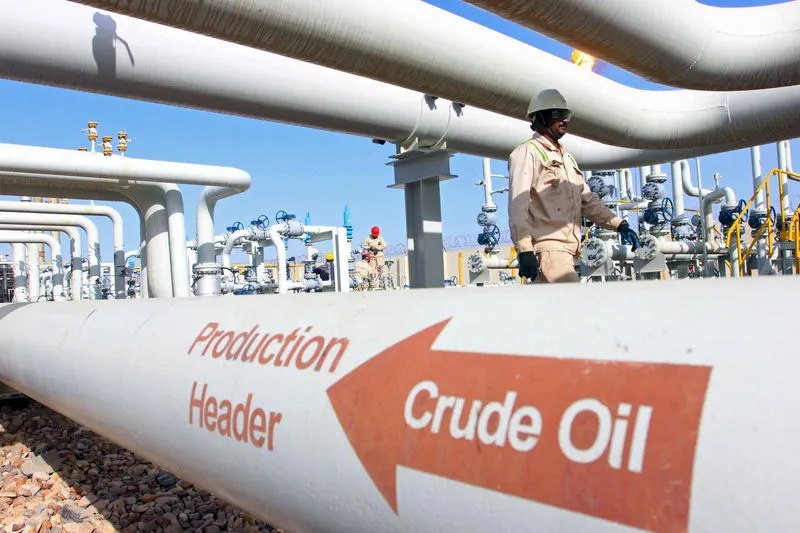
© Reuters.
LCO
-1.06%
Add to/Remove from Watchlist
Add to Watchlist
Add Position
Position added successfully to:
Please name your holdings portfolio
Type:
BUY
SELL
Date:
Amount:
Price
Point Value:
Leverage:
1:1
1:10
1:25
1:50
1:100
1:200
1:400
1:500
1:1000
Commission:
Create New Watchlist
Create
Create a new holdings portfolio
Add
Create
+ Add another position
Close
CL
-0.96%
Add to/Remove from Watchlist
Add to Watchlist
Add Position
Position added successfully to:
Please name your holdings portfolio
Type:
BUY
SELL
Date:
Amount:
Price
Point Value:
Leverage:
1:1
1:10
1:25
1:50
1:100
1:200
1:400
1:500
1:1000
Commission:
Create New Watchlist
Create
Create a new holdings portfolio
Add
Create
+ Add another position
Close
DXY
+0.32%
Add to/Remove from Watchlist
Add to Watchlist
Add Position
Position added successfully to:
Please name your holdings portfolio
Type:
BUY
SELL
Date:
Amount:
Price
Point Value:
Leverage:
1:1
1:10
1:25
1:50
1:100
1:200
1:400
1:500
1:1000
Commission:
Create New Watchlist
Create
Create a new holdings portfolio
Add
Create
+ Add another position
Close
Investing.com — Oil prices edged higher Tuesday, helped by raised tensions in the Middle East, but gains are limited given concerns that the output cuts announced last week by a group of top producers will not be enough to keep the market tight amid concerns over weakening global demand.
By 09:45 ET (14.45 GMT), the U.S. crude futures traded 1.1% higher at $73.85 a barrel and the Brent contract climbed 1.1% to $78.91 a barrel.
Both contracts were trading just above their weakest levels since early-July, after having recorded six straight weeks of heavy losses.
Fears of a potential escalation in the Israel-Hamas conflict came back into play after the U.S. held Iran responsible for an attack on U.S. vessels in the Red Sea by Houthi forces. But traders remained wary of pricing too high a risk premium into oil over the conflict, given that it so far had minimal impact on Middle Eastern oil supplies.
Skepticism over OPEC’s voluntary cuts
The crude market recorded losses of around 2% last week, despite the Organization of the Petroleum Exporting Countries and allies, including Russia, a group known as OPEC+, agreeing output cuts of about 2.2 million barrels a day for early next year.
Comments by Saudi Arabia’s energy minister that OPEC+ production cuts could continue past the first quarter of 2024 have provided some support, but gains are limited given skepticism over the voluntary nature of the proposals.
Additionally, Russia indicated the cuts agreed by the OPEC+ group will take time to kick in, with the market wary that Moscow may try to talk up the need for cuts while producing as much as possible to fund the ongoing war in Ukraine.
Global economic concerns
At the same time, the global economic outlook continues to look troubled heading towards the end of the year.
Ratings agency Moody’s (NYSE:MCO) cut its outlook on China’s government credit ratings to negative from stable earlier Tuesday, in the latest sign of mounting global concern over a deepening property crisis in the world’s second-largest economy.
Data released earlier Tuesday also showed that the downturn in eurozone business activity eased last month, with the region’s composite PMI rising to 47.6 from October’s near three-year low of 46.5.
However, this still indicates the bloc’s economy will contract again this quarter, after falling 0.1% last quarter, indicating the region is on track for a recession.
In the United States, data on Tuesday showed factory orders fell by more than analysts had expected in October and the most in more than three years, raising concerns about the health of U.S. demand.
Also pressuring oil prices was some resilience in the dollar, which rose sharply in overnight trade. Markets were widely awaiting key nonfarm payrolls data, due this Friday, for more cues on the U.S. economy, amid growing optimism that the Federal Reserve was done raising interest rates.
(Ambar Warrick contributed to this article.)
Source: Investing.com




























